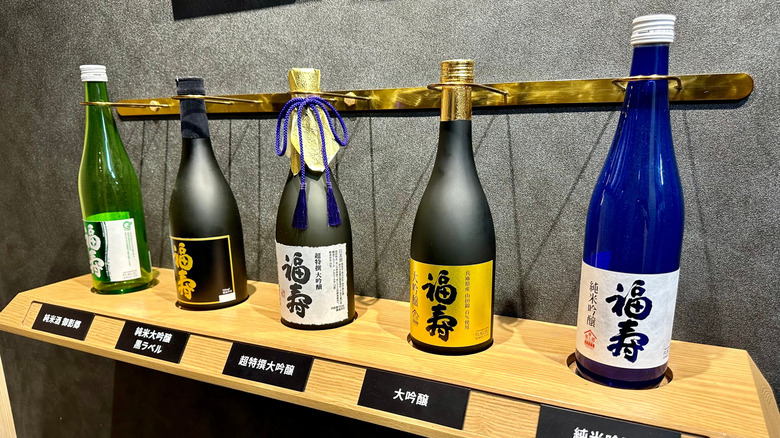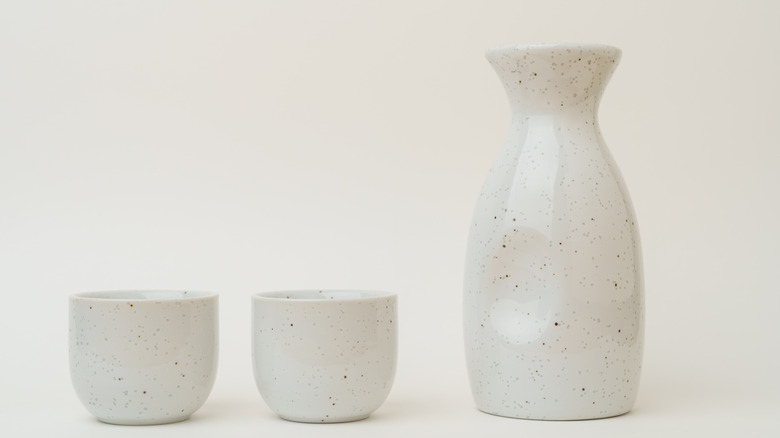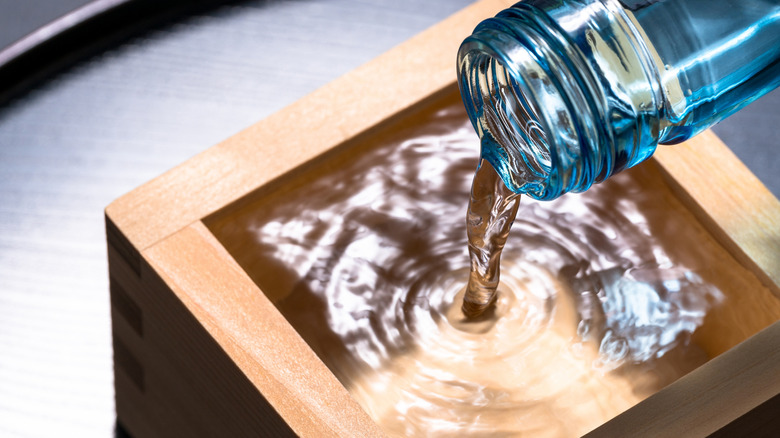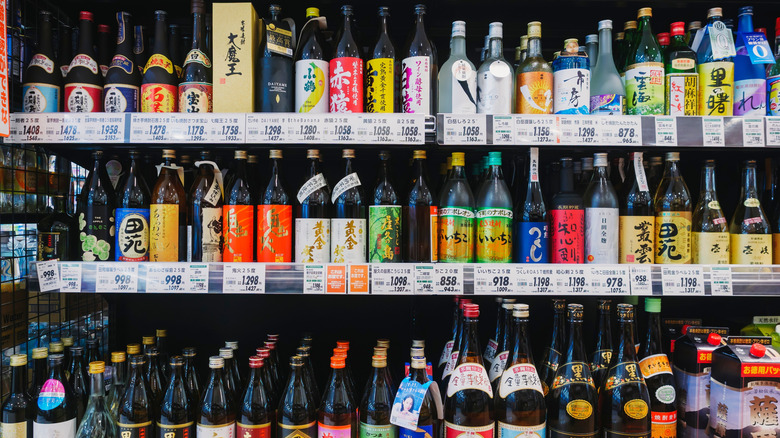7 Types Of Sake, Explained
Unlike the world of standard wine, the fundamentals of sake – and other rice-based spirits — remains more opaque to the average U.S. consumer. Yet just like wine, shopping with intention when it comes to sake (along with a little know-how) can transform a meal from good to life-changing in a few sips.
To learn more about the eclectic universe of sake, I called upon Nina Murphy, owner of Sunflower Sake (located in Portland, Oregon), and Erik and Kana Hansen, co-owners of Fulamingo (a Japanese grocery service also in Portland). These experts enthusiastically elaborated on the details of the popular rice wine and its many varieties, helping expand our understanding of the alcohol's range and diversity.
With their guidance, we were able to demystify all the colorful (and often cute) bottles calling to you from the back of laminated menus and well-lit corners of Japanese restaurants and grocery stores. To help heighten your next sake experience by ensuring you can differentiate between varieties, here are the nitty gritty details behind seven types of sake.
Polishing
Before we untangle the different types of sake, a quick rundown on the polishing process is both helpful and informative. The term polishing ratio is unavoidable when discussing sake's varying characteristics, after all, and refers to the percentage of the grain's surface that has rubbed off — or polished — during the sake-making process.
According to Nina Murphy, polishing ratios "are basically a measure of how much rice has been milled — polished — away from the grain's outer layers." For example, the polishing ratio for brown rice is 100% because it's entirely intact, while white rice is 90%. "With sake," Murphy elaborated, "you take this process even further, whittling each grain down to 70%, 60%, 50%, and so on. Why? Because rice — sake rice varieties especially — have a higher concentration of carbohydrate in their core."
Now, as you might have noticed, a lower polishing percentage means more of the grain has been buffered away from the rice. For instance, a sake with a polishing ratio of 20% indicates it uses grains where 80% has been milled away. As a rule, less polishing results in a fuller-bodied sake, and more polishing leads to a gentler, more delicate drink. "You can expect lighter body and softer texture from high polish," Murphy explained, "fuller body and richer texture from low polish." Still, she added, "the industry is moving away from polishing ratios as an indicator of style or quality. Technology and techniques are starting to make it obsolete."
Junmai
Possibly the truest form of sake, junmai (which translates to "pure rice" in Japanese) is comprised solely of rice, water, koji, and yeast. Koji, a cornerstone of Japanese kitchen culture, provides the enzymes for the starches in sake to feed on. This initiates the process for yeast to transform into sugar, therefore jumpstarting the fermentation process. While other sake varietals tend to include steps where alcohol is added during the fermentation process, junmai sake earns its alcohol content while sealed in the bottle.
Since one of the highlights of sipping these luxurious liquids is learning to pair sakes with the perfect meal (like with wine), junmai offers a good starting place for the sake curious. As Kana Hansen told Tasting Table, "If you love junmai-style sake and want to try something a little more expensive, a nicer junmai will give you a good basis for comparison." Additionally, as you begin to shop around for sake, you'll likely notice how sub-categories can fall into both the junmai classification as well as a tier of their own. This is because the term junmai points to the process and ingredients inside the bottles.
Nina Murphy leans on junmai sakes during the winter months. She relies "more on the deep savory notes of caramelized vegetables, golden chicken skin, mushrooms, root vegetables, and comforting fatty ingredients. This time of year there is nothing better than mushroomy-tasting lightly or deeply aged junmai served warm or room temperature."
Ginjo
Somewhat of a newcomer to the sake world, ginjo sake's prominence only dates back about a half century. Containing a minimum of 60% polishing, ginjo tends to veer lighter than other sake varietals due to its extended polishing. Great for anyone who has found other sakes to be too sweet or dense, ginjos offer a brighter entryway into the world of rice-based alcohol.
Of course, given the polishing ratio, ginjos often boast a higher price tag than other sakes thanks to the lengthier preparation process. Then again, according to Kana Hansen, you can consider your money well spent if paying a little extra for ginjo.
As Hansen told us, "The Japanese sake market is fairly priced. If a sake requires more labor and care, it will be more expensive. In general, if you are comparing two sake of the same style, the more expensive bottle will tend to give you something that is more refined in flavor, body, and balance." With that in mind, feel free to enjoy the premium status of ginjo sakes, but perhaps save them for special sipping occasions.
Daiginjo
Similar to ginjo, daiginjo refers to a more premium level of sake. More than that, since daiginjo translates to "big ginjo" in English, it's clear that daiginjo also undergoes a lengthy polishing process (just like its smaller cousin). A minimum of 50% of the rice grains are polished off, in fact, with sake makers employing their finest grains to produce bottles that are often the priciest of all offerings.
"Daiginjo is a style which tends to always be higher priced, because they take more care and labor to produce," Erik Hansen stated. Of course, like perfumes and other tastes based on highly personal preferences, daiginjo can carry a "very particular flavor profile, so just because it's expensive doesn't mean you will love it more."
While this subsect of sake might be known for floral, fruity undertones, you shouldn't necessarily expect to find those pinkish notes sealed in every bottle of daiginjo. Consequently, Nina Murphy organizes her rice wine shop according to flavor profile rather than types of sake. After all, as Murphy explained, "There are junmai that taste like daiginjo, and deliberately aged, mushroomy junmai ginjo that bear no resemblance to the fruity, floral style most people expect from that classification."
Honjozo
In a previous slide, I detailed how junmai sake must only contain rice, water, and koji, while also ensuring the fermentation process occurs while the spirit is sealed in the bottle. On that note, honjozo sake points to a sake manufacturer skirting the regulations of a junmai classification and introducing another element into the wine-making process.
While the sake's trio of key ingredients remain present, honjozo sake contains small amounts of brewer's alcohol added to the mash. However, despite the process it completes before drinking, honjozo doesn't always equate to a sweeter, boozier drink. In fact, as a rule, the additional alcohol introduced to the sake's mash cannot total more than 10% of the sake's rice weight.
A process implemented to impact subtle aromas, chances are the flavor of most honjozo sakes still rely more on the choice of rice and koji than the hint of extra booze. Either way, sakes in the honjozo style veer mild and less complex than other varietals. Kana Hansen suggests you turn to honjozo "if you want something warm," as this will help bolster its soft profile.
Namazake
Like all sake types, knowing the English translation helps to understand the category in broad strokes. Meaning "fresh" or "raw" in Japanese, namazake is notable for skipping parts of the fermentation process. While other sakes are heated during fermentation to ensure a stable finished product, namazake sashays over the heating step entirely. As a result, it can be more temperamental than other varieties, and requires reliable transportation and storage.
Namazake sake tends to carry tart, acidic, lively notes — the sort that can pair well with hot weather food. Nina Murphy expands by detailing how "fresh crisp summer vegetables, sweet tomatoes and corn and herbs, fresh cheeses and chilled tofu, are always spectacular with fruity and crisp namazake. Nama is usually best served cold, it is expressive, higher in acidity, lightly effervescent, but still has a dense core of umami and sweetness that interacts beautifully with the fresh natural sweetness of summer ingredients."
Additionally, because namazake skips the pasteurization process, many sake producers limit the number of bottles produced. Instead, producers may release several seasonal bottles representing the time of year they were bottled as opposed to a single sake label. These can be perfect gifts for a wedding, birthday, or any other date-based celebration, and tying a bow around a bottle of namazake (with storage instructions) is a sneakily unique present option for spirit enthusiasts.
Sparkling
Like wine, sake contains a subsect of bubbly bottles for occasions and taste buds who enjoy a perky burst while drinking. Aimed at catching the attention of drinkers unaccustomed to rice wines, the sparkling sake market has steadily grown since the 1990s, now enjoying a champagne-like treatment from a handful of respected sake producers.
As for the flavor profile, Kara Hansen noted "sparkling sake tends to be a little sweeter. I like to think of sparkling sake as more akin to wines like Bugey Cerdon or Moscato d'Asti and drink them in similar fashion: paired with fruit clafoutis, cheese, and charcuterie. It is also great for casual afternoon-sunshine-porch-time." Additionally, Erik Hansen noted one of his favorite bottles (Seaside) works similarly to France's long-celebrated champagnes when paired with oysters.
Like champagne and other sparkling wines, carbonated sakes are best served chilled, with light foods, and with the intention of celebration. And although the traditional glassware for sake ranges from shot glass-sized options to handheld bowls, presenting sparkling sake in champagne flutes further showcases the uplifting mood of the bottle.
Infusions
Inferring the definition of infused sakes isn't that difficult. Simply put, infused sakes include an extra burst of flavor by an outside ingredient — most commonly fruit. A cursory glance at sake shelves will show an overwhelming amount of infused sakes opt for yuzu: an Asian citrus somewhere between a Meyer lemon and a tangerine, with an extra spike of tropical zing all its own. Beyond that, pickled plum (or umeboshi), flowers, apples, and much more can be used to intensify a sake's flavor.
Now, as with any infused alcohol, not all yuzu sakes are created equal. While some artificial infusions are available, higher-quality sakes will contain real juices. Nina Murphy added, "The infused sake we carry (at Sunflower Cafe) are all whole food ingredients: sake, fruit, rock sugar, or sometimes just the natural sweetness of the koji. When an infused sake like umeshu is good, it tastes better than the actual fruit itself ... it's like the platonic ideal of that fruit."
Infused sakes are a sharp tool for bartenders, and a handy drink to have on hand if your company wants to try something new. If someone you know enjoys lemon drops, yuzu sake (and other infusion options) mix well with additional liquors, and taste great with just a little soda water for a low ABV imbibement.








